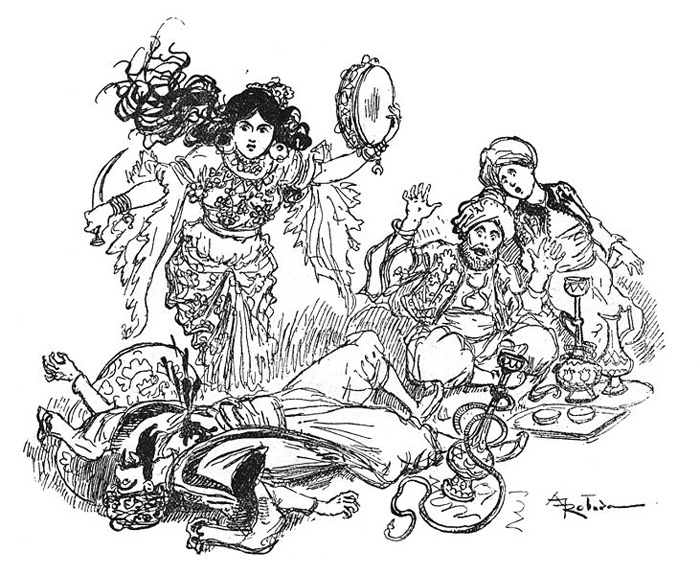
Edmund Dulac (1882-1953); illustration beauty and the beast
I upon a time, a Tunisian Ogre of Greek origin named Mustapha Khaznadar (أبو النخبة مصطفى خزندار) , whose real name Georgios Kalkias Stravelakis.
Kardamila Born in 1817 on the island of Chios, it is said that he was the distant descendant of the famous cyclops Polyphemus and would be the grandfather of an Ogre raging recently in Tunisia for many years before escape ... not without a win in his trunks an important part of the Treasury National ...
... Moreover, the Khaznadar name means "Thief Treasure ...
Kardamila Born in 1817 on the island of Chios, it is said that he was the distant descendant of the famous cyclops Polyphemus and would be the grandfather of an Ogre raging recently in Tunisia for many years before escape ... not without a win in his trunks an important part of the Treasury National ...
... Moreover, the Khaznadar name means "Thief Treasure ...

Khaznadar Mustapha, Minister of Finance of the Regency of Tunis and then grand vizier from 1855 to 1873
captured with his brother Yannis in 1821, he was taken Izmir and Istanbul where it is sold as a slave to an envoy of the Bey of Tunis. Raised in the family by Mustafa Bey Bey, then by his son Ahmed I Bey while it was still crown prince, he managed to climb to the highest positions in the Tunisian State: He married Princess Lalla Kalthoum in 1839 and sees himself promoted to Lieutenant-General Bey army in 1840 and then president of the Grand Council from 1862 to 1878.

Kay Nielsen (1886-1957), Illustration for Thousand and One Nights
Khaznadar Mustapha, who became finance minister Ahmed I Bey then in 1837 the grand vizier of Muhammad Bey in 1855, establishes a deplorable financial policy for the country by imposing an extremely heavy taxation and by borrowing in France. Moreover, abuses are made by the governors of cities and tribal leaders.

Illustration Leon Bakst (1866-1924)
In 1864, under the leadership of Ben Ali Ghedhahem, cities of the Sahel and the tribes south-western rebel cries of: "More building! More taxes! More Mamluk! ". The government then asked if the Bedouins do not besiege Tunis so the insurgency is gaining ground. But the insurgents lacked unity of purpose and action Khaznadar and the opportunity to sow division among them. It instructed the General Ahmed Zarrouk suppress the insurgency. The repression was particularly ruthless in the Sahel. The Bey suspended the constitution of 1861 and the tax rate is reduced by half but Khaznadar and the Mamluks, who came to save the regime of the insurgency remain in power because they are more indispensable than ever to the sovereign.

Aubrey Beardsley (1872-1898), Ali Baba , 1897
Succeeding events, prolonged drought descends on the country. It is even more disastrous than the food reserves are exhausted and the men in power have taken no steps to prevent its consequences. Poverty is rife in the country in 1867 and the capital is not immune: he died from 100 to 150 people per day from hunger or typhus.

Albert Robida (1848-1926); illustration Ali Baba
In these difficult circumstances, Mustapha Khaznadar away the treasure of the State his own benefit from 1868, including municipal revenues. The budget of the municipality of Tunis is thus reduced to the modest grant habous. In 1873 the place has finally fall Khaznadar: General Kheireddine Pasha, then president of the international financial commission created by the Bey in 1869, presented to the sovereign, in a hearing at the Palais du Bardo in complicity with the Bookmark Mustapha Ben Ismail, said a report by the commission accusing it of misappropriating Khaznadar 2000 requirements representing two million francs. The evidence is overwhelming and cons Khaznadar he must confess his guilt. Khaznadar then offered his resignation and is replaced by General Kheireddine.

Albert Robida (1848-1926); illustration Ali Baba
In Tunis, the public is very impressed by these events that qualify then revolution. Population manifests its joy and thanksgiving ceremonies were held in all mosques, the Medina of Tunis is illuminated for three days and the artisans and merchants of the souks show their gratitude to the Bey by sending delegations to the Bardo and present. It also provides horse racing and other festivities.

Albert Robida (1848-1926); illustration Ali Baba
Isolated and hated by all, Khaznadar died July 26, 1878 in Tunis, but sees himself buried Tourbet El Bey in the heart of the medina of Tunis. He remained in the collective imagination of the Tunisians as the Ogre who plundered the country's income for thirty years, symbolizing the decline of the monarchy Bey.
Article loosely inspired by Wikipedia

Albert Robida (1848-1926); illustration Ali Baba
NDLA: For my part, I want to say I have nothing to do with this family of ogres that we are fighting the same for centuries ...

Albert Robida (1848-1926); illustration Ali Baba
0 comments:
Post a Comment